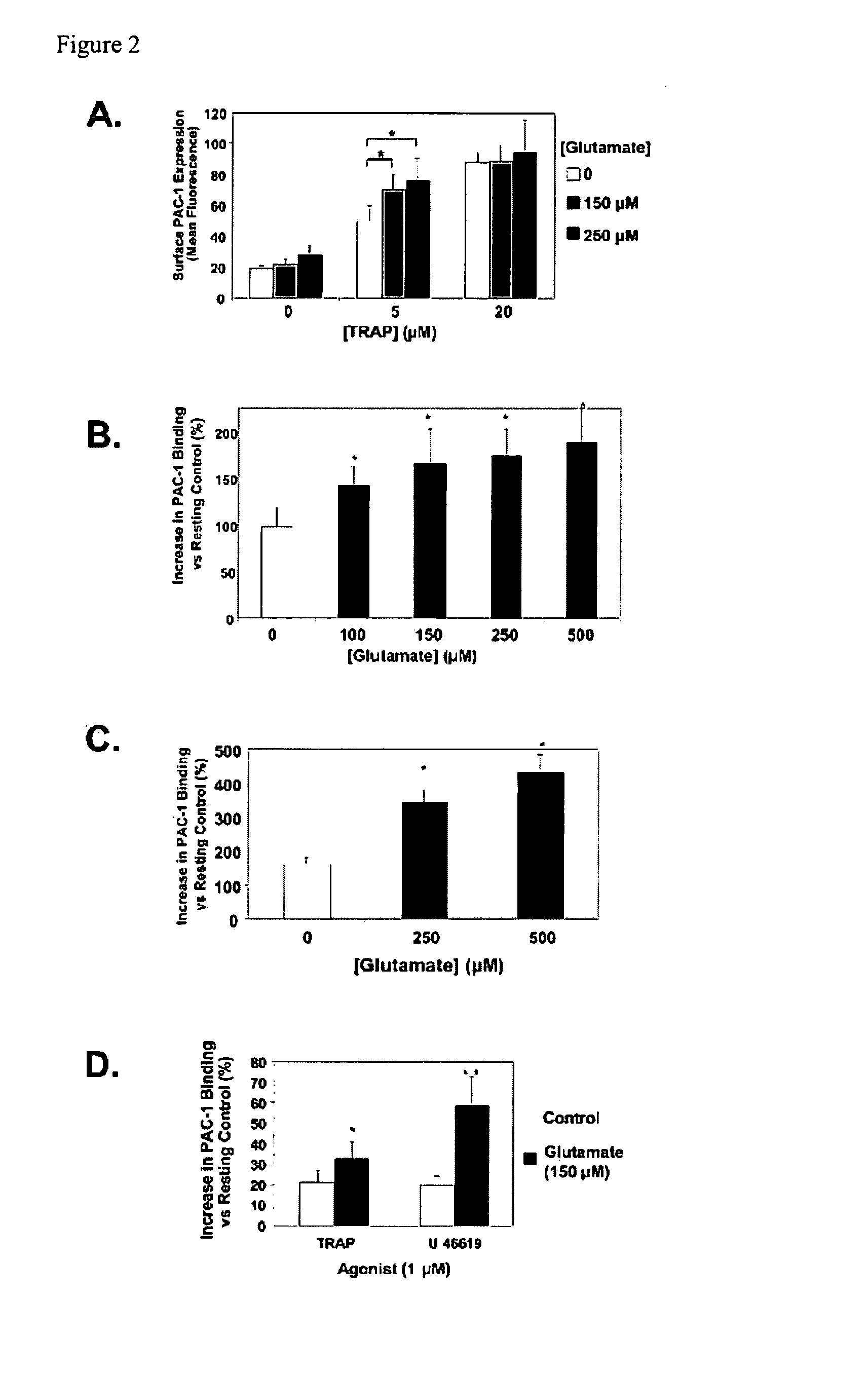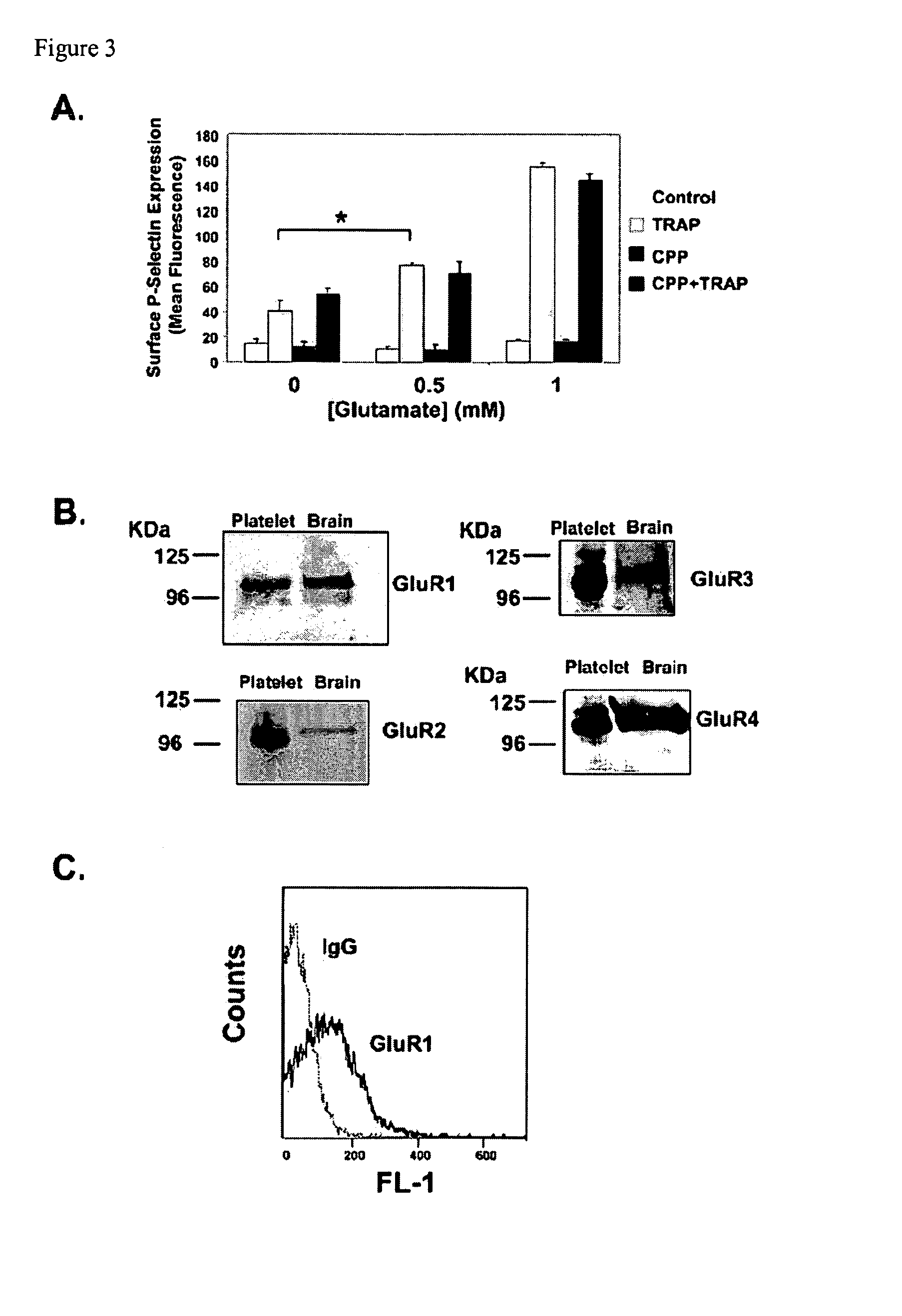Glutamate receptor antagonists and methods of use
a glutamate receptor and antagonist technology, applied in the field of glutamate receptor antagonists, can solve the problems of limited functional studies of peripheral glutamate signaling and its role in vascular physiology, increased thrombotic risk, and increased mortality, and achieve the effect of modulating platelet activity and thrombosis, and increasing plasma glutamate levels
- Summary
- Abstract
- Description
- Claims
- Application Information
AI Technical Summary
Benefits of technology
Problems solved by technology
Method used
Image
Examples
example 1
Glutamate Release during Thrombus Generation Increases Platelet Activation
[0437]Platelets store glutamate, express glutamate transporters, and release glutamate during activation, but vascular targets of glutamate have not been characterized (13, 14, 16, 24, 25, 33). To define the role of platelet derived glutamate in the vasculature, we first quantified platelet glutamate release locally within a developing thrombus using a glutamate sensitive enzymatic probe. The probe provides continuous real time glutamate concentration measurements by glutamate oxidase catalyzed conversion of glutamate to alpha-ketoglutaric acid and hydrogen peroxide. Hydrogen peroxide is then ampomerically detected (34). Whole blood was diluted in Tyrode's buffer (1:1) and glutamate concentration was measured during thrombin (0.5 U / mL) initiated platelet aggregation. Glutamate increases rapidly during platelet aggregation to concentrations exceeding 400 μM (FIG. 1 A-B). It was next determined whether glutamate...
example 2
Glutamate Mediates Platelet Activation and Aggregation through the AMPAR
[0439]Next, it was sought to identify the glutamate receptor that augments platelet activation. Others have demonstrated the presence of the NMDA type glutamate receptor (NMDAR) on platelets, but this appears to have a different role in platelet function (20, 22, 23). To determine whether NMDAR mediates glutamate activity, NMDAR was blocked with (±)-3-(2-Carboxypiperazin-4-yl)propyl-1-phosphonic acid (CPP) and then treated platelets with glutamate before stimulating with TRAP. NMDAR inhibition does not inhibit glutamate mediated increase in platelet activation (FIG. 3 A). It was therefore explored whether platelets express another type of ionotropic glutamate receptor. By immunoblot the presence of AMPA receptor (AMPAR) subunit proteins GluR1-4 was demonstrated (FIG. 3 B). Expression of the AMPAR subunit GluR1 was also localized to the platelet surface using flow cytometry (FACS) with an antibody specific for an...
example 3
Platelet AMPAR Signaling Induces Sodium Influx and Platelet Depolarization
[0447]In the open state AMPA receptors are permeable to Na+, and depending on its subunit isoform composition, can also be selectively permeable to Ca2+. To determine if platelet AMPAR increases Na+ influx into platelets, platelets were pre-incubated with the Na+ sensitive dye sodium-binding benzofuran isophthalate (SBFI) and next added control, AMPA (1 mM), CNQX (100 μM), or both. Platelets were then activated or not with TRAP. It was found that AMPA increases intracellular Na+ concentration by approximately two times upon activation as compared to control (FIG. 5 A). CNQX not only decreases Na+ concentrations in platelets treated with AMPA and TRAP, but CNQX also decreases Na+ levels in platelets treated with TRAP alone (FIG. 5 A).
[0448]These data demonstrate that the AMPAR mediates an increase in intracellular Na+. To confirm that the AMPA receptor mediates Na+ influx independent of the Na+ / H+ exchanger (NH...
PUM
| Property | Measurement | Unit |
|---|---|---|
| temperature | aaaaa | aaaaa |
| bleeding time | aaaaa | aaaaa |
| bleeding time | aaaaa | aaaaa |
Abstract
Description
Claims
Application Information
 Login to View More
Login to View More - R&D
- Intellectual Property
- Life Sciences
- Materials
- Tech Scout
- Unparalleled Data Quality
- Higher Quality Content
- 60% Fewer Hallucinations
Browse by: Latest US Patents, China's latest patents, Technical Efficacy Thesaurus, Application Domain, Technology Topic, Popular Technical Reports.
© 2025 PatSnap. All rights reserved.Legal|Privacy policy|Modern Slavery Act Transparency Statement|Sitemap|About US| Contact US: help@patsnap.com



